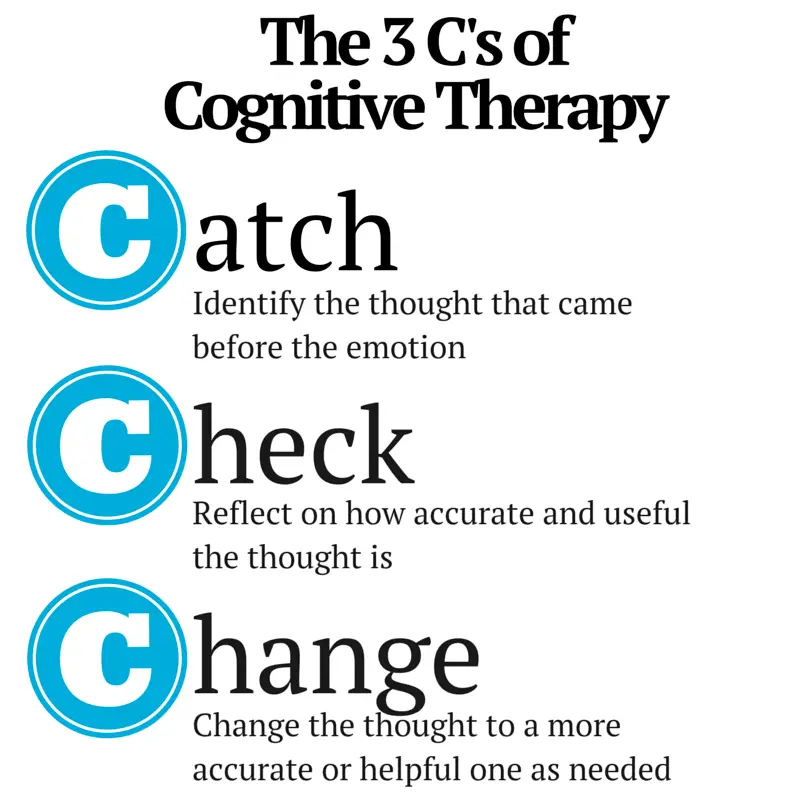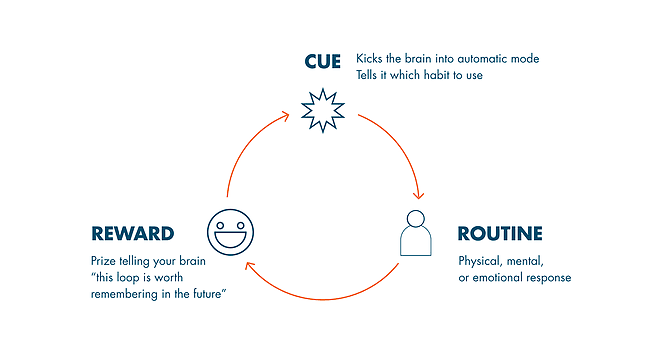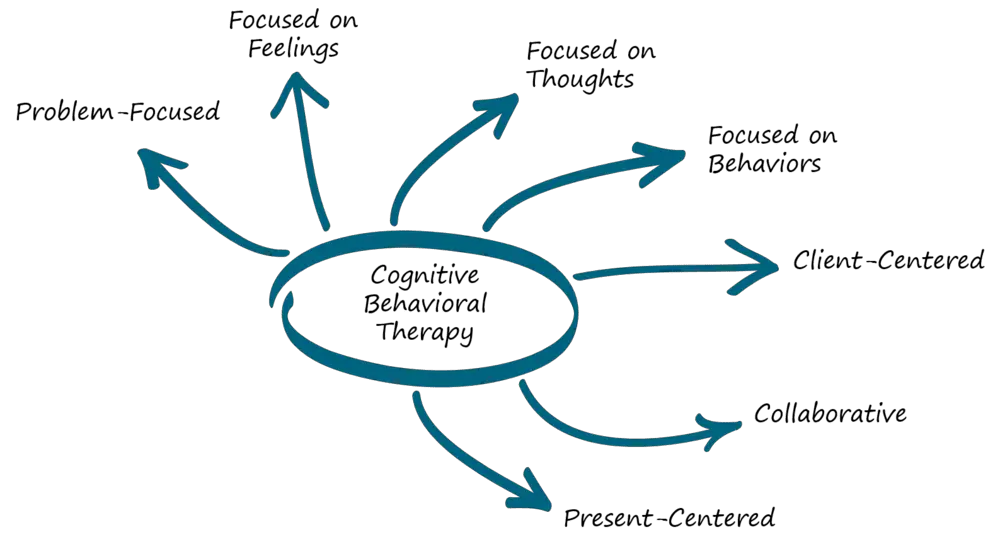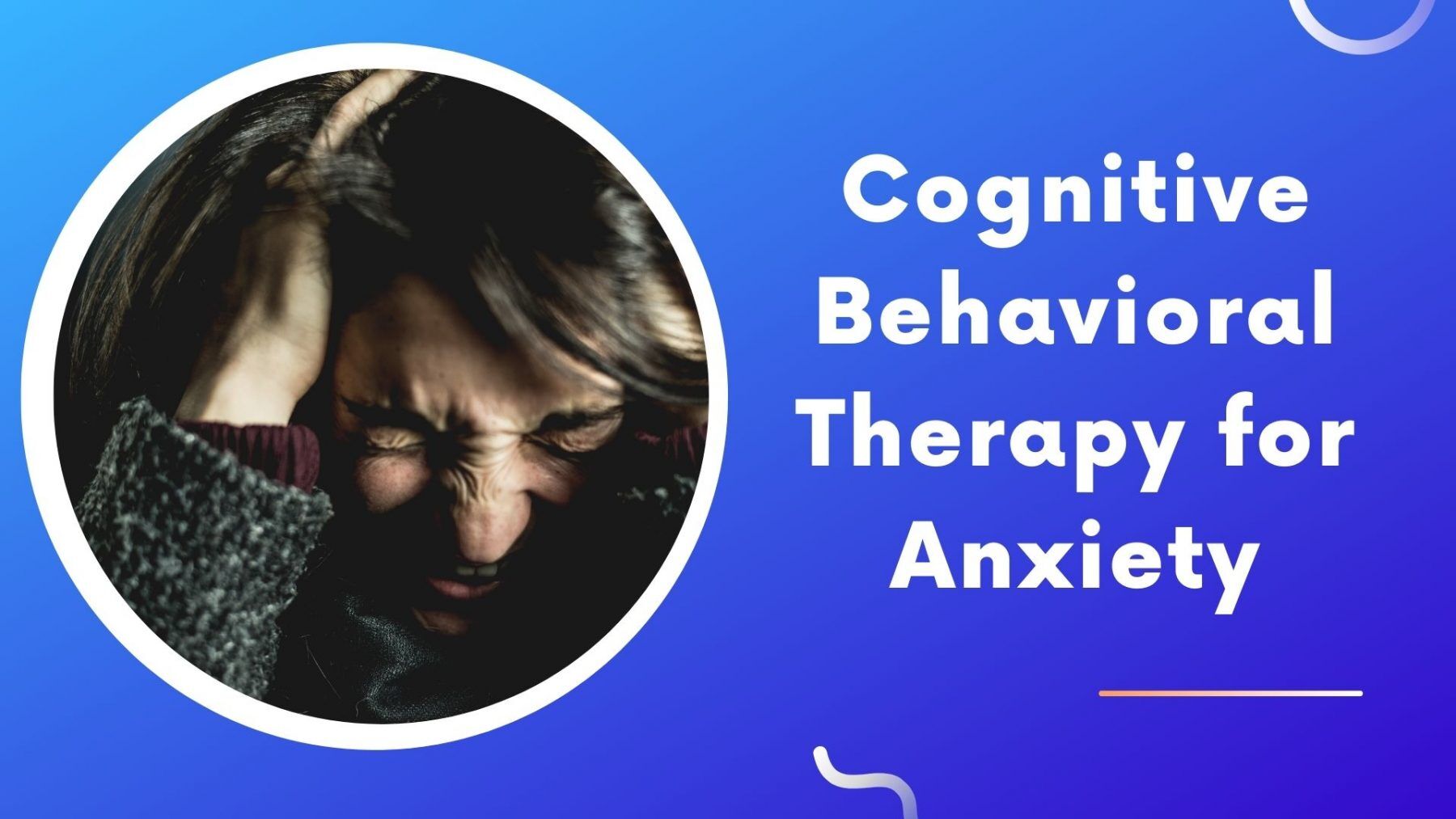Anxiety is often left untreated, or only poorly treated.
In America, anxiety disorders are the most common mental health concern. Even more than Binge Eating Disorder!
19% of Americans have an anxiety disorder according to the National Alliance of Mental Illness. This dwarfs the number of people with Binge Eating Disorder (3%).
Plus, anxiety and binge eating go hand in hand many times.
In this post, we will discuss the basics of CBT for treating anxiety:
- what is CBT for anxiety
- how CBT works
- who benefits from CBT
- and more!
What Is Cognitive Behavioral Therapy For Anxiety?
CBT is a form of treatment which helps people identify and alter negative thoughts and beliefs about themselves, their world, or the future.
The reason CBT works on anxiety is because it can help reduce symptoms such as:
- Repetitive worrying-thoughts (obsessive-compulsive disorder)
- Panic attacks (panic disorder)
- Social anxiety disorder
- Separation Anxiety
- Post Traumatic Stress Disorder (PTSD)
- Lack of assertiveness
- Public speaking problems
- Relationship boundary-setting problems
Why can CBT work with all these mental health concerns? CBT is designed to positively affect the way you think and feel.
Plus, CBT also utilizes techniques from what is known as exposure therapy. In exposure therapy you expose yourself to things you fear – like food, people or public speaking.
Eventually through exposure therapy, you naturally start treating anxiety!
Then when you use CBT to work on your negative thoughts AND behaviors, you really get a recipe for success!
That’s why CBT is recognized by many healthcare providers as an effective treatment. Not only for anxiety but other mental health conditions and substance abuse problems.
How Does Cognitive Behavioral Therapy (CBT) For Anxiety Work?

CBT works on anxiety because if you think about it, anxiety is caused by your thoughts.
When we experience anxiety, it’s typically because of a thought (or thoughts) that has occurred to us.
For example: “I don’t want people to judge me” or “What if I get sick when I’m traveling?”
With CBT, you get a structured therapy approach to help you change these thoughts. One key step includes challenging those thoughts that are contributing to your anxious feelings. Then these thoughts become more manageable.
As part of CBT therapy for anxiety, a person may notice thoughts like ‘I will make mistakes’ or ‘I’ll embarrass myself’.
They would then work with these thoughts to come up with new interpretations such as:
“It’s ok for me not to be perfect” or “No matter what happens I’ll be ok.”
In other words, CBT teaches you how to change your thinking styles so that they are less anxiety-provoking.
Step By Step CBT Techniques (A Big Picture Overview)
In CBT, the first step to treat anxiety is to learn about your anxiety cycle.
The idea is that you want to know what negative thoughts, feelings and behaviors lead up to high levels of anxiety for you.
First, you identify the specific worries and stresses — the cues — that cause pain in your life. Then CBT teaches therapy skills which help you change them to a more positive outlook on life.
This may include relaxation exercises or cognitive restructuring techniques (like changing beliefs).
Relaxation exercises in CBT are aimed at reducing the symptoms of anxiety.
Cognitive restructuring is a technique that aims to change our negative thoughts to make them more positive, realistic and useful.
Self-talk can be a way to achieve cognitive restructuring for changing beliefs. For example, if you think “I always screw things up”, this may lead to feeling anxious when you believe even worse outcomes are likely.
With CBT, we would counteract this belief with an alternative such as “It doesn’t have to go wrong all the time.”
There are many other CBT techniques, but the idea behind all of them is that by altering how we think, we can reduce feelings of distress.
CBT Case Study
Being able to catch your cues (or triggers) is very important in CBT.
Here is a short client testimonial video demonstrating the power of CBT.
In this video the client solves their binge eating problem using CBT therapy principles.
And the woman in the video shares that she stopped bingeing because she learned how to ‘catch her cues’!
And yes, I realize binge eating is different from anxiety but there are many similarities too!
For example, in binge eating the root problem is NOT food but rather the THOUGHTS people have ABOUT food.
Does this sound familiar to anxiety? Yes!
Because in anxiety, the MAIN problem is NOT the anxious situation (public speaking), but rather the thoughts the person has ABOUT public speaking (i.e., that they’ll fail or be rejected).
Catch Your Cues

Catching your cues is one of the first steps of CBT for anxiety.
This is where you are learning about your anxiety cycle and what cues or triggers cause anxiety to erupt in your life.
For binge eating, this woman really had to be diligent and keep a journal in order to understand her cues.
By recording her anxiety before she ate food, she started catching what triggered her binges. She avoided some binges entirely in this manner!
Of course, she didn’t JUST catch her cues. She also learned exposure therapy techniques like progressive muscle relaxation to remain calm.
Progressive muscle relaxation is where you relax one muscle group at a time to decrease stress. Like you relax your stomach, then your jaw, then your legs.
Why Should I Consider Cognitive Behavioral Therapy For Anxiety?

There are a lot of reasons why someone might want to consider CBT as a therapy option in treating their anxiety:
The number one reason is that CBT works really well for anxiety!
CBT is effective at reducing levels of distress with different types of disorders.
This includes Generalized Anxiety Disorder (GAD), Panic Disorder, Social Phobia – all those “big” ones.
Also, CBT can be a good therapy option for people who want to avoid the use of medications.
Medication is not always necessary as long as someone’s anxiety symptoms are mild. And with CBT it’s possible to get relief without medication.
And even if you’re on meds now, your therapist may recommend that you taper off after CBT.
This is because there are no negative side effects with CBT!
Who Can Benefit From Cognitive Behavioral Therapy For Anxiety
Anyone with some type of anxiety problem can benefit from CBT. This includes:
- People who are struggling with anxiety disorders, including Generalized Anxiety Disorder (GAD), Panic Disorder, Social Phobia, and Obsessive-Compulsive Disorder
- Children aged five through thirteen who have fears of separation or social situations
- Adults with mild to moderate depression
If you are suffering from anxiety, CBT is a proven therapy treatment that helps ease symptoms.
How To Find a Therapist Near You That Specializes in CBT
If you’re looking for CBT, here are some therapy resources to help:
- Try a search engine for “Cognitive Behavioral Therapy near me””.
- Contact your medical insurance company. They may have an online directory of providers. You can see if they offer CBT as one of their covered benefits or how much it would cost out-of-pocket.
- Look up therapists who specialize in CBT on Psychology Today’s website. Then contact them directly with any questions about availability.
How To Get Started With Your First Appointment
It can be difficult deciding which therapist is right for you before scheduling your first therapy appointment – but don’t worry!
Here are a few tips to get started:
- Contact the therapist and ask them about their specific CBT techniques. This will help you determine if they’re a good fit for your needs. And remember to inquire how many therapy sessions are needed to see results!
- Ask about confidentiality, insurance, as well as any costs or fees associated with CBT. Don’t sign any contracts or submit payment information info without this!
- Research CBT online
- Read this science article on CBT!
Final Thoughts
Cognitive behavioral therapy (CBT) is a type of therapy that aims to change the way people behave by changing their thinking patterns.
CBT in clinical studies and in real life is an effective therapy treatment for anxiety disorders.
If you’re looking for ways to fight your anxiety symptoms while also taking care of yourself, consider seeing a therapist who specializes in CBT!
For even more info on CBT read here!




